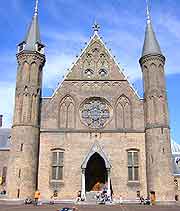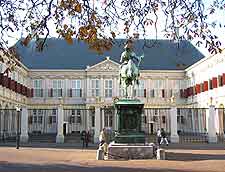The Hague History Facts and Timeline
(The Hague / Den Haag, South Holland, Netherlands)

The history of The Hague started sometime around the mid-13th century. First, land in the area was bought by the Count of Holland, ostensibly to build himself a hunting lodge.
Later, Count William II gave orders for a castle to be built here. His son Floris V extended the castle, adding what is known as the Knights' Hall. A town gradually grew up in its shadow.
The Middle Ages
By 1400, The Hague was a moderate-sized medieval town. Unusually for a town at this time, it still didn't have its own defensive wall. The story goes that when the townsfolk were offered the chance to build defensive walls around the town, they turned the offer down. Instead, they built a town hall. It has to be said that in the 16th century, a defensive wall would have been extremely useful. At war with the Spanish and left vulnerable to attack, The Hague ended up being burnt down.
French Rule and After
In 1806, under French rule, The Hague received official city status - a huge event in Dutch history. Then, in 1814, when the French had departed, the city became the capital. This role was eventually taken by
Amsterdam and The Hague became the seat of government of an independent Kingdom of the Netherlands. Instead, The Hague became the seat of government of an independent Kingdom of the Netherlands.
In the 19th century, The Hague expanded rapidly as a result of the Industrial Revolution. Rural workers rushed here in search of a better life. The city was forced to spread outwards to meet the demand for houses. It is at this point that many of the canals in the city were filled in, to be turned into roads.

The World Wars
In World War One, Dutch neutrality meant that The Hague escaped any serious damage. During World War Two, however, many of the poorer areas of The Hague were completely destroyed during bombing raids. As a base for the German V-2 rocket building programme, it clearly made a prime target.
Some houses were destroyed by the Germans as well, when they cleared the way for the building of the Atlantic Wall. In the post-war period of history, The Hague started to recover. As people began to move back into the city to live and work, it became clear that more houses were needed. Modern residential districts sprang up in the city and in neighbouring areas. These included the Schilderswijk district.
Modern Times
Today, The Hague is the capital of southern Holland. It is also the home of the International Court of Justice and the International Criminal Court. Tourists will find that the heart of the city is where much of the oldest architecture resides, while the elegant Plein square is filled with pavement cafes and partially bounded by imposing government buildings.
 The history of The Hague started sometime around the mid-13th century. First, land in the area was bought by the Count of Holland, ostensibly to build himself a hunting lodge.
The history of The Hague started sometime around the mid-13th century. First, land in the area was bought by the Count of Holland, ostensibly to build himself a hunting lodge.